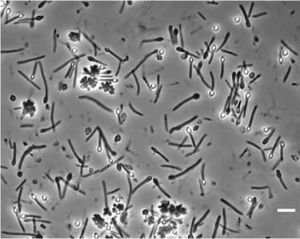Moorella thermoacetica: Difference between revisions
| (12 intermediate revisions by 3 users not shown) | |||
| Line 1: | Line 1: | ||
{{Uncurated}} | {{Uncurated}} | ||
[[File:Moorella_thermoacetica.jpeg|300px|thumb|right|Figure 1: Moorella thermoacetica cells in culture]] | |||
==Classification== | ==Classification== | ||
Kingdom: Bacteria | Kingdom: Bacteria | ||
Phylum: Firmicutes | Phylum: Firmicutes | ||
Class: Clostridia | Class: Clostridia | ||
Order: Thermoanaerobacterales | Order: Thermoanaerobacterales | ||
Family: | |||
Genus: | Family: Thermoanaerobacteriaceae | ||
Genus: Moorella | |||
Species: thermoacetica | Species: thermoacetica | ||
==Species== | |||
''Moorella thermoacetica'' | |||
''' | |||
''Moorella | ==Significance== | ||
''Moorella thermoacetica'' is a model acetogen. Its simple metabolism and location within anaerobic, warm waters have suggested that this organism is related to some of the earliest forms of life on Earth. | |||
==Genome Structure== | ==Genome Structure== | ||
| Line 32: | Line 34: | ||
Further analysis of the 16S rRNA sequences were pivotal in proving that acetogenesis is a metabolic trait rather than a phylogenetic trait. | Further analysis of the 16S rRNA sequences were pivotal in proving that acetogenesis is a metabolic trait rather than a phylogenetic trait. | ||
==Cell Structure | ==Cell Structure and Metabolism== | ||
Moorella thermoacetica cells are gram-positive and rod shaped, they ranging in size from 0.4 to 2.8 micrometers and possess peritrichous flagella though it lacks motility; the cells will form circular, opaque colonies. M. thermoacetica spores are spherical and most often are formed sub-terminally within the sporangium. | Moorella thermoacetica cells are gram-positive and rod shaped, they ranging in size from 0.4 to 2.8 micrometers and possess peritrichous flagella though it lacks motility; the cells will form circular, opaque colonies. M. thermoacetica spores are spherical and most often are formed sub-terminally within the sporangium. Moorella thermoacetica is an acetogenic bacteria that can autotrophically produce acetate by reducing carbon dioxide. Acetogenesis can be formed via the acetyl coenzyme A pathway or the Wood–Ljungdahl pathway.exception. Indeed, M. thermoacetica is one if the most metabolically diverse acetogens that uses a variety of substrates. This bacterium grows hetrotrophically and autotrophically , and it uses nicotinic acid, the only organic nutritional requirement. | ||
==Ecology | ==Ecology== | ||
Moorella thermoacetia's acetyl-CoA pathway is centrally important in cycling of carbon in various environments .<br> | |||
In nature, Moorella thermoacetica is found in soil, at the bottom of stagnant ponds. M. thermoacetatia is globally distributed in soils that experience periodic thermophilic temperatures and is anaerobic. The bacterium is a thermophile, growing at 58°C (140°F). | |||
<br><br> | |||
==References== | ==References== | ||
[http://www.sciencedirect.com/science/article/pii/S0923250804002372 Drake, H.L., Daniel, S.L. (2004) Physiology of the thermophilic acetogen Moorella thermoacetica. Research in Microbiology 155: 869-883.] | |||
[http://link.springer.com/article/10.1007%2Fs00203-008-0435-x Jiang, B., Henstra, A.M., Paulo, P.L., Balk, M., Van Doesburg, W., and Stams, A.J.M. (2009) Atypical one-carbon metabolism of an acetogenic and hydrogenogenic Moorella thermoacetica strain. Archives of Microbiology 191: 123-131.] | |||
[http://www.ncbi.nlm.nih.gov/pmc/articles/PMC2575129/ Pierce. E., et al, 2008. The complete genome sequence of Moorella thermoacetica (f. clostridium thermoacetica) Environ Microbiol. 10 (10):2550-73] | |||
==Author== | ==Author== | ||
Page authored by Thomas Wilson, Leena Babiker and Esther Dzikushie, students of Professors Ned Walker and Kaz Kashefi, Michigan State University. | Page authored by Thomas Wilson, Leena Babiker and Esther Dzikushie, students of Professors Ned Walker and Kaz Kashefi, Michigan State University. | ||
<!-- Do not remove this line-->[[Category:Pages edited by students of | <!-- Do not remove this line-->[[Category:Pages edited by students of Michigan State University]] | ||
Latest revision as of 13:41, 29 April 2014
Classification
Kingdom: Bacteria
Phylum: Firmicutes
Class: Clostridia
Order: Thermoanaerobacterales
Family: Thermoanaerobacteriaceae
Genus: Moorella
Species: thermoacetica
Species
Moorella thermoacetica
Significance
Moorella thermoacetica is a model acetogen. Its simple metabolism and location within anaerobic, warm waters have suggested that this organism is related to some of the earliest forms of life on Earth.
Genome Structure
The complete genome of M. thermoacetica was sequenced in 2008. Upon completion it was the first acetogen to be mapped.
The genome consists of a single circular chromosome with 2,628,784 base pairs with a GC (guanine-cytosine) content of 56%. Seventy percent of the predicted 2523 protein-encoding genes had been assigned known functions, with the remaining having an unknown purpose.
Specific clusters including those linked to the Wood-Ljungdahl pathway and autotrophy were confirmed.
Further analysis of the 16S rRNA sequences were pivotal in proving that acetogenesis is a metabolic trait rather than a phylogenetic trait.
Cell Structure and Metabolism
Moorella thermoacetica cells are gram-positive and rod shaped, they ranging in size from 0.4 to 2.8 micrometers and possess peritrichous flagella though it lacks motility; the cells will form circular, opaque colonies. M. thermoacetica spores are spherical and most often are formed sub-terminally within the sporangium. Moorella thermoacetica is an acetogenic bacteria that can autotrophically produce acetate by reducing carbon dioxide. Acetogenesis can be formed via the acetyl coenzyme A pathway or the Wood–Ljungdahl pathway.exception. Indeed, M. thermoacetica is one if the most metabolically diverse acetogens that uses a variety of substrates. This bacterium grows hetrotrophically and autotrophically , and it uses nicotinic acid, the only organic nutritional requirement.
Ecology
Moorella thermoacetia's acetyl-CoA pathway is centrally important in cycling of carbon in various environments .
In nature, Moorella thermoacetica is found in soil, at the bottom of stagnant ponds. M. thermoacetatia is globally distributed in soils that experience periodic thermophilic temperatures and is anaerobic. The bacterium is a thermophile, growing at 58°C (140°F).
References
Author
Page authored by Thomas Wilson, Leena Babiker and Esther Dzikushie, students of Professors Ned Walker and Kaz Kashefi, Michigan State University.

